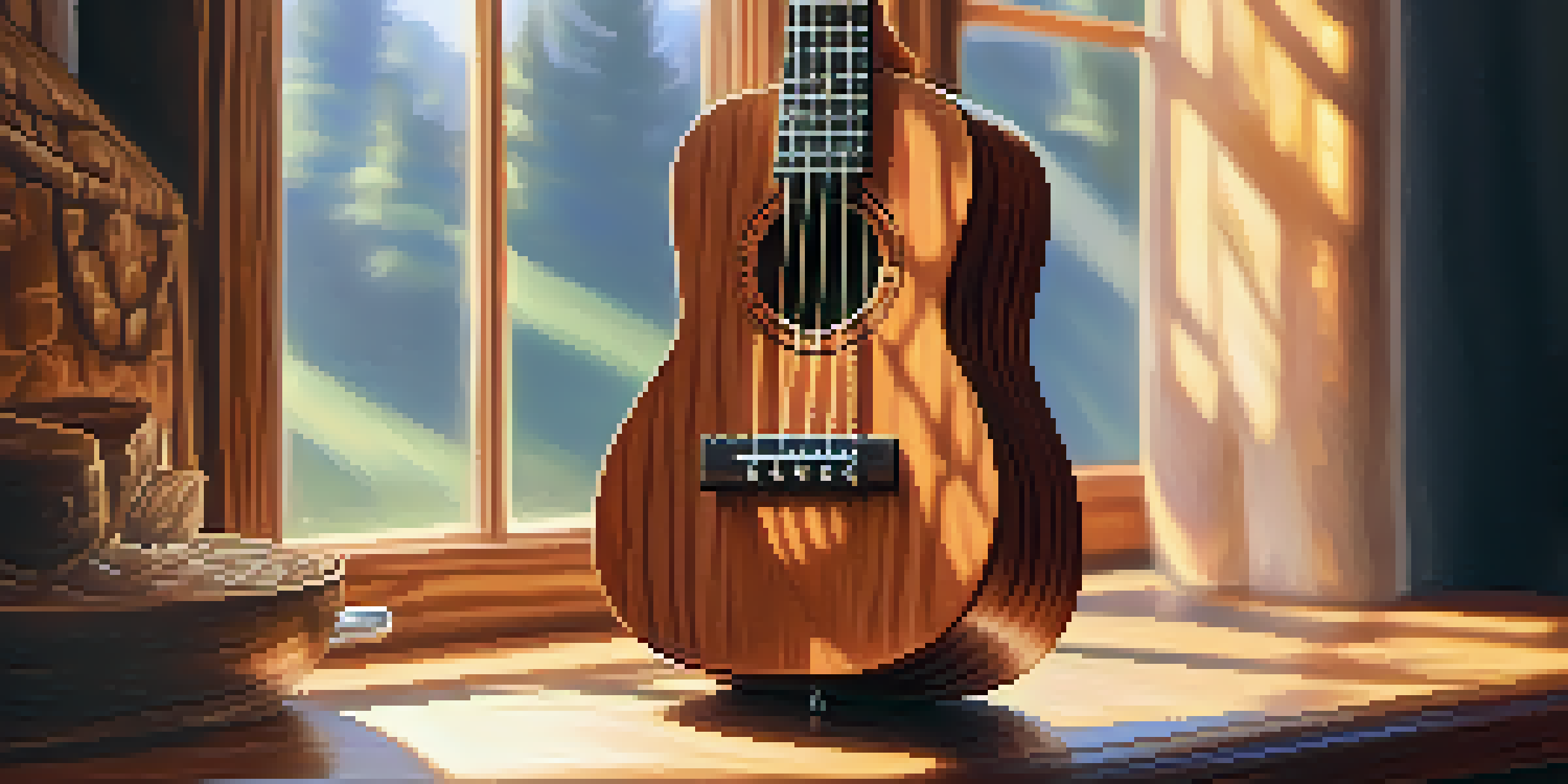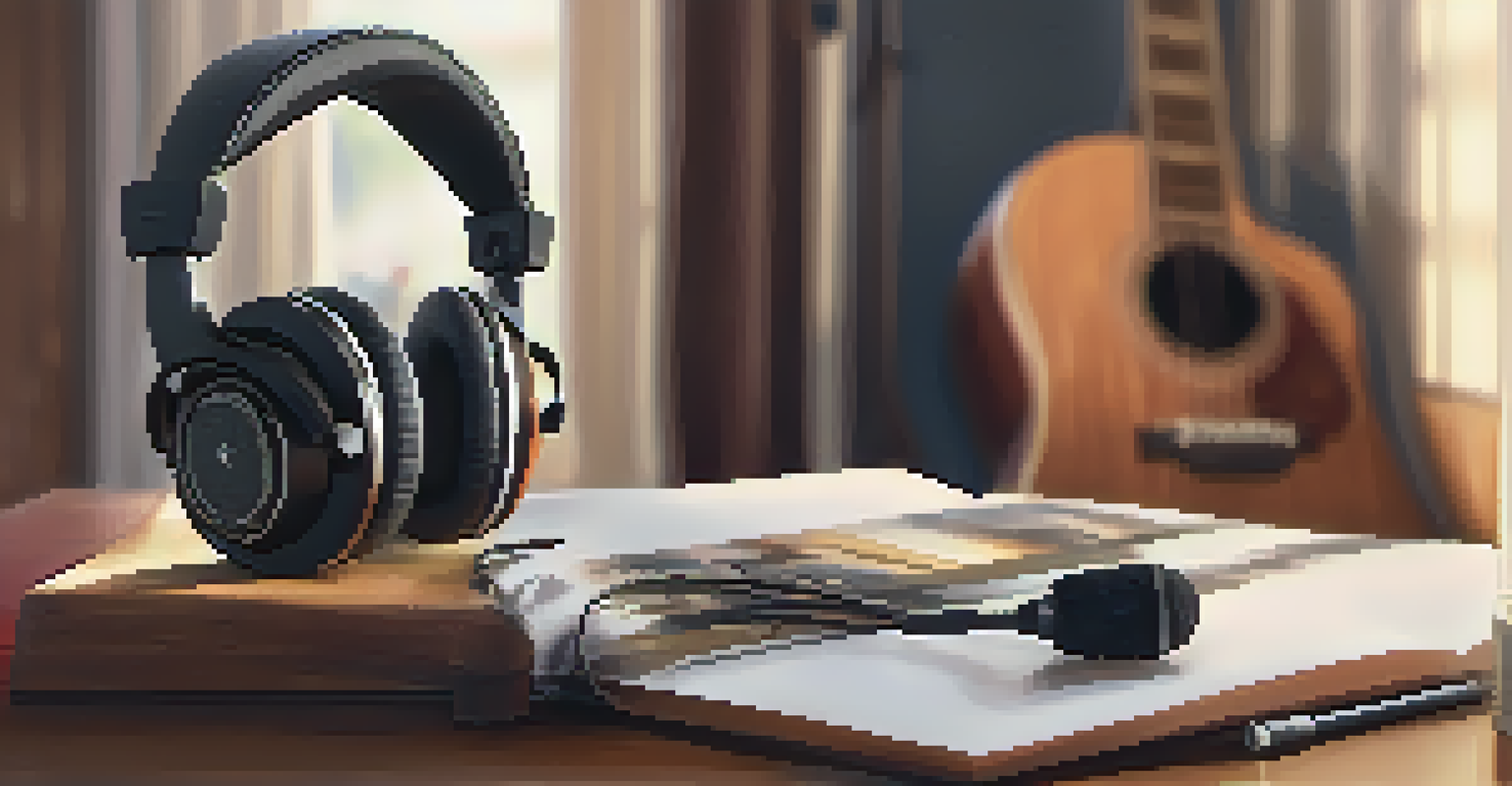Essential Gear for Recording Ukulele Music at Home

Choosing the Right Ukulele for Recording
When it comes to recording ukulele music at home, the first step is selecting the right instrument. A quality ukulele can make a significant difference in your sound. Whether you opt for a soprano, concert, or tenor model, ensure it resonates well and suits your playing style.
The ukulele is a beautiful instrument, and it can be expressive and profound beyond its size.
Consider the materials used in the ukulele's construction. Solid wood options often provide a richer tone compared to laminate models. If you can, try out different types before making a purchase to find the one that feels and sounds right for you.
Lastly, don’t forget about the strings! Upgrading to high-quality strings can enhance your ukulele’s sound. Experimenting with different string materials can also help you achieve the tone you desire during your recording sessions.
Microphones: Capturing the Perfect Sound
The microphone you choose is critical for capturing your ukulele's sound accurately. Condenser microphones are often recommended for home recording due to their sensitivity and ability to pick up subtle nuances in your playing. They’re great for both vocals and instruments.

For a more budget-friendly option, consider a USB microphone, which can connect directly to your computer. This makes it easy to start recording right away without needing extra equipment. Just ensure it has good sound quality to avoid any disappointing results.
Choose the Right Ukulele
Selecting a quality ukulele tailored to your playing style is crucial for achieving a richer sound during recordings.
Positioning your microphone correctly can also make a big difference. Experiment with different distances and angles to find the sweet spot that captures the best sound. Sometimes, even a slight adjustment can elevate your recordings significantly!
Audio Interface: Bridging Instrument and Computer
An audio interface is essential for connecting your ukulele and microphone to your computer. It converts analog signals into digital ones, allowing for high-quality recordings. This is especially important if you’re using professional studio microphones.
Recording is not just about technology; it's about capturing the spirit of the moment.
Look for an interface with at least two inputs, which gives you the flexibility to record multiple instruments or vocals simultaneously. Many interfaces also come with built-in preamps, enhancing your sound quality further.
Portability is another factor to consider. If you plan to record in different locations, a compact interface can make your life much easier. Ultimately, choosing the right audio interface will ensure your recordings sound professional and polished.
Headphones: Monitoring Your Sound Accurately
Investing in a good pair of closed-back headphones is crucial for monitoring your recordings. They help you listen to your performance without any sound leakage, allowing you to catch mistakes and make adjustments as you go along. Comfort is key, especially during long recording sessions.
Look for headphones with good sound isolation and a flat frequency response. This will enable you to hear your ukulele’s true tone without any enhancements or distortions. Over-ear models often provide better isolation than on-ear styles.
Microphone Matters for Quality
Using a suitable microphone, like a condenser or a good USB option, significantly impacts how accurately your ukulele's sound is captured.
Don’t forget to test your headphones before buying. Everyone’s ears are different, so what works for one person may not work for another. The right pair can make a world of difference in your recording experience.
Recording Software: Your Creative Playground
Choosing the right recording software, or digital audio workstation (DAW), is essential to your home recording setup. There are many options available, from free software like Audacity to professional-grade programs like Logic Pro or Ableton Live. Each has its strengths, so pick one that matches your skill level and needs.
A user-friendly interface can greatly enhance your recording experience. Look for features like easy track management, built-in effects, and MIDI capabilities if you plan to expand your music production in the future.
Many DAWs also offer extensive online tutorials and communities, making it easier to learn how to use them effectively. Spending time familiarizing yourself with the software will pay off when you start layering tracks and mixing your recordings.
Acoustic Treatment: Enhancing Your Recording Space
The environment where you record can significantly affect sound quality. Acoustic treatment involves adding elements to your space that minimize echoes and background noise. Items like foam panels, rugs, and curtains can help create a more controlled recording environment.
Consider the size and shape of your room; irregular shapes can help diffuse sound. If you’re limited on space, even small adjustments can improve your audio quality. For example, try recording in a closet filled with clothes to absorb sound.
Optimize Your Recording Space
Enhancing your recording environment with acoustic treatments can drastically improve the clarity and quality of your audio recordings.
Additionally, be mindful of external noise sources. Close windows, turn off fans, and choose a time when your surroundings are quieter. A well-treated space will lead to clearer, more professional-sounding recordings.
Accessories: Final Touches for Your Setup
Don’t overlook the importance of accessories to complete your recording setup. A sturdy microphone stand is essential for positioning your mic correctly without any hassle. This allows you to focus on playing rather than juggling equipment.
Pop filters can also be beneficial if you’re recording vocals alongside your ukulele. They help reduce plosive sounds, which can disrupt your recordings. Investing in a good quality pop filter can make your vocal tracks sound cleaner.

Lastly, don’t forget about cables and stands for your ukulele. High-quality cables can prevent interference, while a sturdy stand keeps your instrument safe and easily accessible. These simple additions can enhance your overall recording experience.